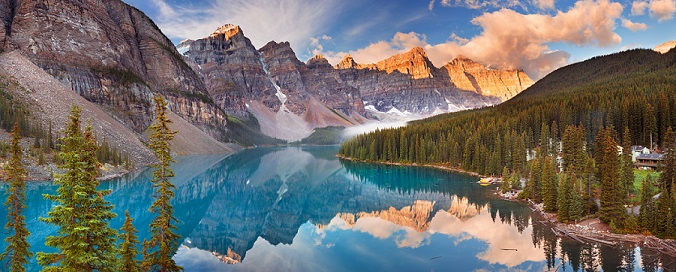
By: David Torres
Banff National Park was established in 1885 making it one of Canada’s first-ever registered national parks. It’s located in the Canadian Rocky Mountains of Alberta just an hour and a half west of Calgary. The park encompasses 1,641,027 acres of diverse ecoregions. It’s surrounded by other protected nature areas on every side including Jasper National Park, Yoho National Park, and Kootenay National Park.
The area that is now known as Banff National Park was first discovered by a group of a railway workers in 1883 when they stumbled upon one of the natural hot springs. Shortly after that, the site was declared a national park. The mountain peaks and local bodies of water of the park have been known to be some of the most beautiful natural sights all year round making it one of the world’s premier destinations.
Activities
The rocky mountain scenery and abundant wildlife of Banff allow for several options of activities throughout the year. Whether you are looking to go hiking during the spring or wanting to enjoy the hot springs during the winter, you can find the perfect activity for you and your group.
You can drive past crystalline lakes and glaciers on paved scenic parkways or stay at one of the 14 diverse campgrounds. One of the most popular activity is taking the gondola ride up the side of the mountains to get a breathtaking view of the park.
History lovers can explore national historic sites scattered throughout the park. There are several museums, natural cave formations, and other historical sites that will provide countless hours of family-friendly fun.
Tours and hiking trails are everywhere in the park all year long. During the winter months, you can book a snowshoeing hike or a guided evening ice walk. Other popular winter activities include cross-country skiing, ice climbing, dog sledding, or going on a horse carriage tour.
During the spring and summer months, Lake Louise is a very popular destination. People will often go on boat tours, kayaking, sail boating, or even scuba diving in the park’s famous lakes. The warmer months are also perfect for horseback riding, rock climbing, bird watching, and mountain biking.
Wildlife
Banff National Park is home to over 50 distinct mammal species that range from the American Red Squirrel to the grizzly bear. This incredible diversity of wildlife is a reflection of the wide range of habitats that can be found in the park due to variations in plant life, elevation, and climate.
Hooved animals such as deer and goats are some of the most common large mammals in the park. The Moose is the largest member of the deer family, commonly about the size of a horse. The best areas in the park to see them are near wet and marshy areas. Deer and Elk can be found near valley bottoms and open areas. They’re also commonly seen around town sites. Bighorn Sheep and Mountain Goats are a little harder to spot due to their preferred habitat. They can be found mostly near steep rocky terrain.
The area is also home to a few carnivores as well. Mountain Lions and Lynx are hard to spot but they’re known to hunt in the area. Wolves are slowing being reintroduce into the park but are still outnumbered by their smaller cousin the coyote. Black bears and grizzlies also call the park home with the larger grizzly bear outnumbering the black bear by quite a bit.
Smaller mammals such as the mink, badger, Wolverine, and skunk are all around the alpine tundra areas of the park. Porcupines and beavers are common in the Lake Louise region and in sub alpine forests throughout the park. Bats, shrews, chipmunks, and squirrels can also be found throughout the parks during various times of the year. In total there are around 29 species of small mammals in Banff National Park.
Price
https://www.pc.gc.ca/en/pn-np/ab/banff/visit/tarifs-fees

Hours of operation
https://www.pc.gc.ca/en/pn-np/ab/banff/visit/installations-facilities
